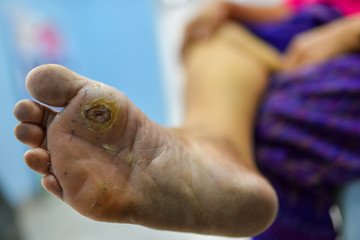“Diabetic Foot Ulcers: Care and Prevention for Healthy Steps”
A diabetic foot ulcer (DFU) is a common yet serious complication of diabetes. Left untreated, it can lead to infections, reduced mobility, or even amputation. The good news? With proper care and preventive measures, you can significantly lower your risk of developing foot ulcers and ensure healthy, pain-free steps.
What Is a Diabetic Foot Ulcer?
A diabetic foot ulcer is an open sore or wound that commonly develops on the bottom of the foot. It occurs due to a combination of:
- Neuropathy: Nerve damage reduces sensation, making it harder to feel pain or pressure.
- Poor Circulation: Reduced blood flow slows down wound healing.
- High Blood Sugar: Elevated glucose levels impair the body’s ability to fight infections and repair tissue.
Symptoms of a Diabetic Foot Ulcer
Look out for these warning signs:
- Redness or swelling
- Drainage from the wound (sometimes with an odor)
- Pain or tenderness in the area
- Thickened or discolored skin
- Changes in the shape of your foot or toes
Complications of Diabetic Foot Ulcers
If untreated, DFUs can lead to:
- Infections: Bacterial infections may spread to deeper tissues or bones.
- Gangrene: Tissue death due to lack of blood supply, requiring surgical intervention.
- Amputation: Severe ulcers can necessitate the removal of a toe, foot, or even part of the leg.
Caring for a Diabetic Foot Ulcer
If you have a foot ulcer, prompt care is essential:
- Seek Medical Attention: Visit a healthcare provider for a thorough assessment and treatment.
- Wound Care:
- Clean the wound with a saline solution.
- Use doctor-prescribed dressings to promote healing.
- Offload Pressure: Use special footwear, insoles, or braces to reduce pressure on the ulcer.
- Manage Infections: Antibiotics may be necessary if an infection is present.
- Control Blood Sugar: Maintain blood glucose levels within your target range to speed up healing.
Preventing Diabetic Foot Ulcers
Prevention is better than cure! Follow these steps to protect your feet:
1. Daily Foot Care
- Wash your feet daily with lukewarm water and mild soap.
- Dry thoroughly, especially between the toes.
- Apply moisturizer to prevent dry, cracked skin—but avoid the spaces between your toes.
2. Inspect Your Feet Regularly
- Look for cuts, blisters, redness, swelling, or any changes.
- Use a mirror or ask someone to help if you can’t see the soles of your feet.
3. Choose the Right Footwear
- Wear well-fitted, comfortable shoes with cushioning.
- Avoid walking barefoot, even at home.
4. Trim Nails Carefully
- Cut nails straight across and file sharp edges to prevent ingrown nails.
- Seek professional help if you can’t trim them yourself.
5. Control Diabetes
- Keep blood sugar levels within the target range through diet, exercise, and medication.
6. Avoid Smoking
- Smoking impairs circulation and slows down healing.
7. Regular Check-ups
- Visit a healthcare provider or podiatrist regularly for foot examinations.
When to Seek Help
Seek immediate medical care if you notice:
- Persistent pain or swelling
- Signs of infection (redness, warmth, pus, or fever)
- Wounds that don’t heal or get worse
Take Steps Toward Healthy Feet
Diabetic foot ulcers don’t have to derail your life. With diligent care and proactive prevention, you can keep your feet healthy and avoid complications.
Need expert guidance on managing diabetes and foot care? Contact us today for personalized advice and treatment. Your health is our priority!







